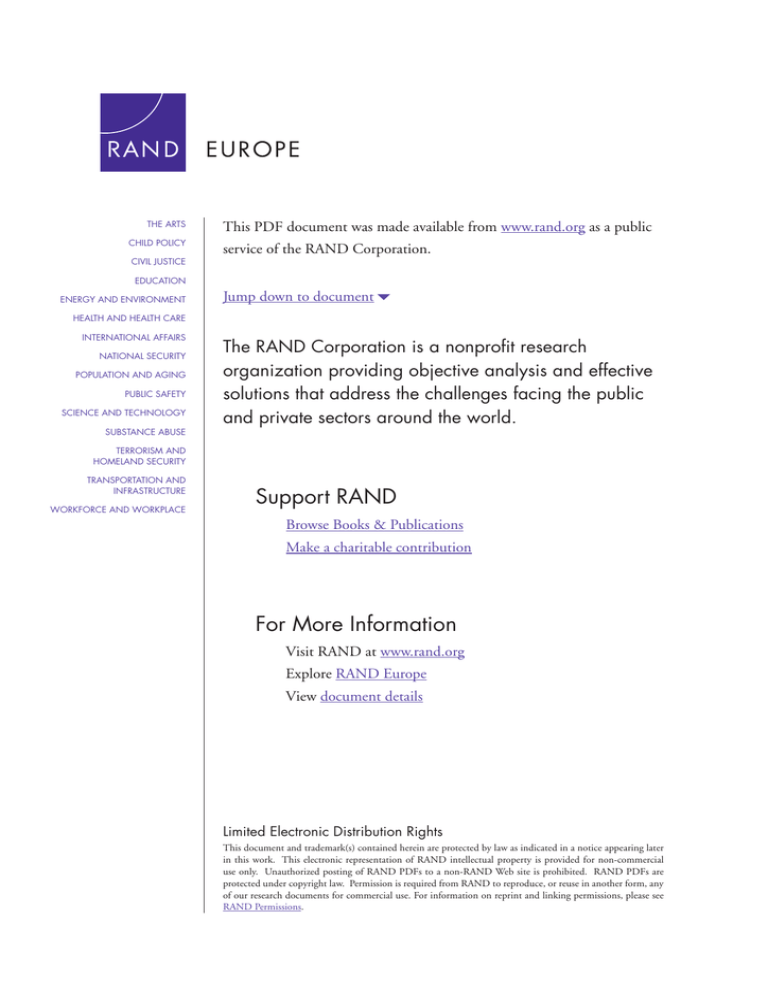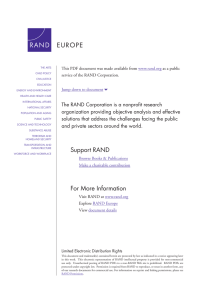
THE ARTS
CHILD POLICY
CIVIL JUSTICE
This PDF document was made available from www.rand.org as a public
service of the RAND Corporation.
EDUCATION
ENERGY AND ENVIRONMENT
Jump down to document6
HEALTH AND HEALTH CARE
INTERNATIONAL AFFAIRS
NATIONAL SECURITY
POPULATION AND AGING
PUBLIC SAFETY
SCIENCE AND TECHNOLOGY
SUBSTANCE ABUSE
The RAND Corporation is a nonprofit research
organization providing objective analysis and effective
solutions that address the challenges facing the public
and private sectors around the world.
TERRORISM AND
HOMELAND SECURITY
TRANSPORTATION AND
INFRASTRUCTURE
WORKFORCE AND WORKPLACE
Support RAND
Browse Books & Publications
Make a charitable contribution
For More Information
Visit RAND at www.rand.org
Explore RAND Europe
View document details
Limited Electronic Distribution Rights
This document and trademark(s) contained herein are protected by law as indicated in a notice appearing later
in this work. This electronic representation of RAND intellectual property is provided for non-commercial
use only. Unauthorized posting of RAND PDFs to a non-RAND Web site is prohibited. RAND PDFs are
protected under copyright law. Permission is required from RAND to reproduce, or reuse in another form, any
of our research documents for commercial use. For information on reprint and linking permissions, please see
RAND Permissions.
This product is part of the RAND Corporation technical report series. Reports may
include research findings on a specific topic that is limited in scope; present discussions of the methodology employed in research; provide literature reviews, survey
instruments, modeling exercises, guidelines for practitioners and research professionals, and supporting documentation; or deliver preliminary findings. All RAND
reports undergo rigorous peer review to ensure that they meet high standards for research quality and objectivity.
2015: A connected and
diversified Europe
eIDM Vision Paper
Constantijn van Oranje-Nassau, Neil Robinson,
Maarten Botterman
Prepared for the e-Government Unit of DG Information Society and
Media, European Commission
EUROPE
The research described in this report was prepared for the European Commission. The
opinions expressed in this study are those of the authors and do not necessarily reflect the
views of the European Commission.
The RAND Corporation is a nonprofit research organization providing objective analysis
and effective solutions that address the challenges facing the public and private sectors
around the world. RAND’s publications do not necessarily reflect the opinions of its
research clients and sponsors.
R® is a registered trademark.
© Copyright 2009 European Commission
All rights reserved. No part of this book may be reproduced in any form by any electronic
or mechanical means (including photocopying, recording, or information storage and
retrieval) without permission in writing from the European Commission.
Published 2009 by the RAND Corporation
1776 Main Street, P.O. Box 2138, Santa Monica, CA 90407-2138
1200 South Hayes Street, Arlington, VA 22202-5050
4570 Fifth Avenue, Suite 600, Pittsburgh, PA 15213-2665
Westbrook Centre, Milton Road, Cambridge CB4 1YG, United Kingdom
RAND URL: http://www.rand.org
RAND Europe URL: http://www.rand.org/randeurope
To order RAND documents or to obtain additional information, contact
Distribution Services: Telephone: (310) 451-7002;
Fax: (310) 451-6915; Email: order@rand.org
Summary
Europe in 2015 may be largely interconnected with pan-European eGovernment services (PEGS)
being delivered to citizens based on a full scale common European electronic Identity
Management (eIDM) system; providing seamless identification and authentication of individuals.
However, it is just as likely that Europeans and their governments resists such coordination of
efforts and interoperability of systems; thus opting for a very minimalist approach to eIDM;
where a common identifier may support a very specific and limited set of basic applications. In
between these two alternative futures we identify a scenario that is largely services driven and
foreshadows a fragmented eIDM environment with different coalitions of countries and
stakeholders, clustered around the utility that each service represents.
The landscape in 2015 will be largely determined by a number of factors:
-
Outcomes of the large scale pilot
Levels of identity
Ambitions: Quality of service
Prevalence of trust
With key drivers being: further European Integration, the implementation of the Services
Directive, the stated ambitions on administrative burden reduction, and parallel private sector
developments
There is no clear incentive for national public authorities for developing pan-European services
for citizens, let alone a full scale European eIDM framework. However there are other
developments and trends that will push or pull further cross border or even pan-European
collaboration in these areas. As these do not all work in the same direction it is likely that a
diversified supply of cross-border and pan-European services will emerge. Likely applications will
be found in health care and in support of worker mobility. A possible third area could be
education. In parallel, the exchange of ID information will increase in the field of law
enforcement and specific niche applications for business sectors. The financial sector is also likely
to go ahead and develop its own platform.
PEGS hold the potential to provide a new impetus to European integration and they may preempt the emergence of a pan-European Administrative space. The current inertia of public
authorities to invest in cross border eIDM models, as well as to adjust legal legacy systems and
coordinate organisational processes, still present a formidable barrier. Thus leadership is required
and needs to be accompanied by effective governance of the process, with a firm hold on the
principle of subsidiarity. The success of any European eIDM depends largely on trust. Trust
iv
RAND Europe
Summary
between Public Authorities (PAs) and trust of the citizens in administrations across the EU to
defend their interests and rights and to deliver concrete benefits.
A European eIDM framework is also expected to yield economic benefits, the assumption being
that businesses will use such an overarching identification system to develop new services. There
is however substantial hesitation from the business community to proceed. The general attitude is
characterised as ‘wait and see’, and for business to invest in any public eIDM system there clearly
needs to be sufficient critical mass of users/consumers. To get the private sector on board earlier
in the process the PAs involved would need to work with existing standards, draw in the business
community to understand their needs, and to involve it in the development of the system. In
particular, care should be taken not to re-invent the wheel and use or reference existing common
standards.
Once effective solutions and good examples at local, national and regional level emerge political
commitment to actual implementation is expected to grow. The current focus on the Large Scale
Pilot is too limited to effectively develop a common eIDM system for Europe; given the various
other platforms and avenues that could be explored and which are in fact being developed
already. Any common solution would require strong leadership, in order to ensure a co-ordinated
approach based on addressing the real needs of users, and facilitate a European application that is
simple, secure, resilient, robust and effective. The most likely feasible and possibly desirable
option is to aim for one common European Identifier; one number based on existing national ID
numbers, without authentication at the EU level.
This raises the issue of what security level would be required for accepting non-nationals to the
system. Either a common EU system is developed with accepted standards for a given set of
applications or any Pan European (PE) application would most likely require the highest security
level, which may still be Public Key Infrastructure (PKI) in 2015. Much also depends on trust
between public authorities. Even the safest systems are worth little if the process of eID
enrolment is fraught with inaccuracy and fraud. It will be difficult to achieve this high level of
trust among citizens of the EU 27 (or maybe 30 by 2015). Thus accompanying measures and
guarantees are required that provide assurance of fraud free enrolment. In addition serious
sanctions for inaccuracies and incompetence need to be in place, as well as guarantees for liability
and damages.
Citizens need to trust that their information is safe and that neither government nor unauthorised
third parties have access to this data. If this cannot be guaranteed or if the perception of abuse
prevails – through actual breaches or false perceptions – the system will fail because of a lack of
users. It should also be envisaged that the system decouples the electronic Identity (eID) from the
personal data, which would allow usage of the (non-personalised) data for socio-economic and
health research purposes.
The expected lacklustre demand could be partially overcome if other actors would have access to
the PE eIDM backbone to support the development of their services, thus creating a multiplier
and a network effect which would increase the overall value of the system. Public spending could
be applied to stimulate take up by the private sector. Also public policy can help creating more
transparency. The plethora of standards, models, specifications, meta-languages and frameworks
risks drowning practitioners in the total number of alternative and possibly incompatible
approaches, leading to a loss of opportunity and effectively doubling the amount of work. It
would be desirable to set up a PE “knowledge centre” on identity management, and “virtual
v
RAND Europe
Summary
middleware” that would support the various different systems across Europe to interconnect by
indicating or referencing which technical middleware would be appropriate to allow different
eIDM systems to interconnect.
vi







